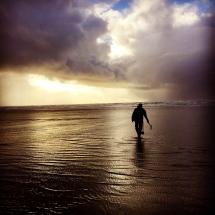ARCHIVED NEWS RELEASE
This document is provided for archival purposes only. Archived documents
do not reflect current WDFW regulations or policy and may contain factual
inaccuracies.
News release Oct. 22, 2019
Dan Ayres, 360-249-4628
Jason Wettstein 360-902-2254
Notice: State shellfish managers have confirmed razor clam openings at Twin Harbors and Long Beach, after testing on Oct. 24 revealed clams at those locations are safe to eat. See the news release for additional information, or visit our razor clams page.
OLYMPIA - Razor clam diggers can return to Mocrocks and Copalis beaches for a seven-day opening beginning Oct. 26.

Twin Harbors and Long Beach digs remain tentative and not approved; require more domoic acid testing to ensure safe digging conditions before approval
State shellfish managers with the Washington Department of Fish and Wildlife (WDFW) approved the dig on evening low tides after marine toxin tests showed the clams are safe to eat on Copalis and Mocrocks beaches.
At this time, Twin Harbors and Long Beach remain tentative and not approved, but additional domoic acid tests conducted by the Washington Department of Health (WDOH) will provide a final determination on those beaches by Friday morning. WDFW will announce whether these beaches have also been approved on Friday as well.
"In the last few days, we've seen increasing levels of the algae that can cause domoic acid in ocean water at Long Beach and Twin Harbors," said Dan Ayres, WDFW coastal shellfish manager.. "Our first priority is safety, and we, working alongside the Department of Health, are reserving judgment on opening of these areas in order to ensure safety for all those who enjoy this activity."
While an unexpected increase in domoic acid in razor clams has been observed in clam samples collected from the surf zones at Long Beach and Twin Harbors, similar increases have not been observed in samples collected at Copalis and Mocrocks.
The upcoming dig is for the following dates and low tides as of Tuesday.
- October 26, Saturday, 5:59 pm, 0.0 feet; Copalis
- October 27, Sunday, 6:47 pm, -0.8 feet; Mocrocks
- October 28, Monday, 7:33 pm, -1.2 feet; Copalis
- October 29, Tuesday, 8:18 pm, -1.4 feet; Mocrocks
- October 30, Wednesday, 9:03 pm, -1.2 feet; Copalis
- October 31, Thursday, 9:50 pm, -0.8 feet; Mocrocks
- November 1, Friday, 10:38 pm, -0.2 feet; Copalis
No digging is allowed before noon for allowed digs, where low tide occurs in the evening.
For a list of proposed razor clam digs on Long Beach, Twin Harbors, Copalis and Mocrocks beaches through December, please see WDFW’s razor clam website. Final approval of the tentatively scheduled openings of all digs depends on whether results of marine toxin tests show the clams are safe to eat.
Additional safety considerations are important to those who engage in digs near dusk and at night.
“Diggers want to be sure to come prepared with good lighting devices and always keep an eye on the surf, particularly at this time of year when low tides come at dusk and after dark,” said Ayres.
WDFW is also asking for razor clam fans around the state to weigh in on the perennial question: Which is
better, clam or shovel? To register support for a favored digging method, clam diggers can post a photo or video, complete with hashtag #TeamClamShovel or #TeamClamGun on any social media before the end of the season.
“Razor clam digs are a major source of livelihood for coastal communities, bringing out hundreds of thousands of tourists each year to enjoy all we have to offer, including terrific nature, food, entertainment and fun on the beach for the whole family,” said Andi Day, Executive Director at Long Beach Peninsula Visitors Bureau. “We value and appreciate WDFW’s work to manage this terrific resource for our communities.”
All diggers age 15 or older must have an applicable 2019-20 fishing license to harvest razor clams on any beach. Licenses, ranging from a three-day razor clam license to an annual combination fishing license, are available on WDFW's website and from license vendors around the state.
Under state law, diggers at open beaches can take 15 razor clams per day and are required to keep the first 15 they dig. Each digger's clams must be kept in a separate container.
WDFW is the state agency tasked with preserving, protecting and perpetuating fish, wildlife and ecosystems, while providing sustainable fishing, hunting and other outdoor recreation opportunities.
To watch a video showing how WDFW maintains sustainable razor clam populations visit this page.